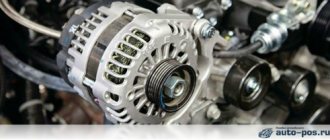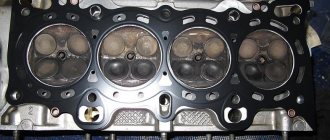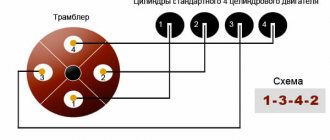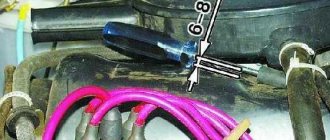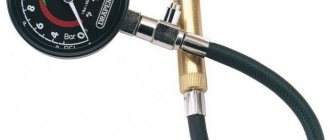Why won't the injector start? Possible causes and solutions
Along with high efficiency and relative reliability, fuel-injected cars have one unpleasant drawback - the difficulty of repair. It happens that the injector suddenly stops starting, and it becomes difficult to do anything with it. It’s good if you have the opportunity to call a tow truck or show the car to a professional, but what should those motorists do who are left with the problem alone? Let's figure it out by examining in detail all the reasons why the injector starts poorly or refuses to start at all, as well as how to “treat” such a malfunction.
Possible faults
No matter how trivial it may sound, if the injector does not start, it means something has gone wrong. The success and speed of repair depends on how quickly and efficiently the problematic link in the car’s design can be identified. To better understand the essence of repair activities, it would be a good idea to pay attention to potential breakdowns. The basic list of the latter is as follows:
In addition to the breakdowns described above that can break the operation of the injector, the problem may lie in more trivial things. An example of this is a weak battery charge or lack of fuel in the tank. Considering just such incidents, before repairing a car, it is extremely important to exclude the possibility of their occurrence, so as not to waste extra time and nerves.
The procedure for returning the car to “life”
Let's say you find yourself in circumstances where the injection engine starts poorly or refuses to do so at all. There is no need to hesitate in such a situation - it is advisable to immediately begin resuscitation procedures. If you don’t have time to figure out the exact reason why the car doesn’t start well, then you should quickly carry out the following algorithm of actions:
In general, there are no particular difficulties in repairing a non-starting injector. The main thing in the process of such work is to act competently, in accordance with the procedure and possible vehicle malfunctions described above.
Prevention of injector breakdowns
Why the injection engine does not start and how to eliminate possible problems is now known to all readers of our resource. However, it is better to avoid such breakdowns, so let’s pay attention to ordinary procedures that, if carried out systematically, will help minimize the risks of all malfunctions. The simplest but most effective prevention consists of the following measures:
Perhaps this is where the most important information on today’s issue has come to an end. We hope the material presented above was useful and provided answers to your questions. Good luck in operating and maintaining your car!
Source
If the engine does not start - injector
The injector design, thanks to the computer and various sensors, is more complex, and therefore there are more vulnerable links in such an engine compared to a carburetor engine. It is more difficult to find the source of the problem. It happens that a car with an injector starts poorly or does not start at all (if the carburetor does not start, and also if the diesel engine does not start). What, in this case, needs to be checked first?
GASOLINE PUMP
A functioning fuel pump produces a characteristic sound. If there is a suspicion that it is faulty, then this suspicion can be confirmed or refuted by checking the spark plugs: if they are dry, then the problem is in the fuel pump. What has failed in the fuel pump - wires, fuse or relay - remains to be determined. How to check the fuel pump
First, we check the integrity of the wires going to the fuel pump to see if they are oxidized. To do this, other, new wires need to be connected directly from the battery to the fuel pump. If the fuel pump works normally with them, then you need to change the standard wires.
If everything is in good condition - the fuse, relay and fuel pump wires, but the latter nevertheless does not work, we can only conclude that the fuel pump itself has become unusable and requires replacement (replacing the fuel pump on a VAZ). Again, to check the serviceability of the fuel pump, you need to connect it to the battery directly, or, instead, connect a working fuel pump.
RAIL PRESSURE
It happens that the injector does not start due to the lack of sufficient pressure in the fuel rail (normally, it should not fall below 2.8 kg/cm²). This can happen if the fuel pressure regulator is malfunctioning.
A dirty fuel filter also prevents normal pressure in the fuel rail. It is better to change the fuel and air filters more often.
Good to read: if the car starts and immediately stalls, if the engine stalls at idle, if the engine doesn’t start well when cold, why the engine doesn’t start well when hot
CRANKSHAFT SENSOR
This is the only sensor, if it is faulty the engine will not start at all. If any other sensors malfunction, the performance of the injection engine only worsens. How to check the crankshaft sensor
INJECTORS
As you know, injectors become unusable one at a time, and nothing bad will happen to the engine if only one injector does not function. It may be worse (there will be tripping), but the engine will work.
To identify a faulty injector, you need to start the engine and touch the exhaust manifold pipes. The pipe that turns out to be colder than the others will indicate the cylinder that is not working. By the way, the cylinder may not work not only due to the fault of the injector, but also due to the fault of a failed spark plug. In this regard, if a faulty cylinder is identified, its spark plug needs to be checked.
IGNITION SYSTEM
In an injection engine, you need to check the ignition module and spark plugs.
How to check the ignition module How to check the spark plugs
If an injection engine does not start, the cause may be an unregulated ignition. There is a very simple way to install the ignition.
GAS DISTRIBUTION SYSTEM
Unadjusted valves in themselves, as a rule, are not the reason that the engine does not start at all. If the valve clearances are wrong, the engine will start, but it will simply run worse. Unadjusted valves can pose a serious problem for starting the engine, in combination with some other malfunction. If there is not one problem, but several (including incorrect valve clearances), then the engine may not start. So adjusting the valve clearances can help fix this problem (how to adjust valves).
Also, the engine will not start if an error was made when installing the timing belt (how to set the timing marks).
Video: VAZ 2110 fuel pump (injector) does not work, looking for the reason
If the video doesn't show, refresh the page or click here
Video: Why a fuel-injected car won’t start
If the video doesn't show, refresh the page or click here
Reasons why the injection VAZ 2114 does not start
The design of any modern car, the VAZ 2114 is no exception, is such that the successful production of a car depends on a number of positions. Previously, this was enough for the mechanical pump to supply fuel to the carburetor, and for the spark plugs to produce a spark. Today there are a lot of problems that prevent the engine from starting. An electronic injector requires the participation of several sensors, and the matter is not limited to them. In this article we will tell you why not and how to deal with it.
In general, all causes of malfunction can be divided into two large categories:
The most terrible malfunctions can be included in a separate category - for example, a “knocking” VAZ 2114 engine, a broken timing belt and, as a result, bending of the valves. In these situations, expensive repairs cannot be avoided.
Fuel system problems
Among the elements of the fuel system, the following factors influence engine starting:
Also included in this category are electrical components that are directly related to the fuel supply. This is an electric fuel pump and a fuel pump relay.
Before checking other methods, you must be completely sure that the VAZ 2114 with an injector is filled. “Yes, there are still five liters there” according to the indicator on the tidy or “I filled it up yesterday, I couldn’t spend that much” are not suitable. The gauge may be lying, and there may be leaks in the tank or fuel lines. Carefully check the car for fuel leaks; just in case, fill in 5-7 liters of gasoline from a canister.
The mesh in the tank rarely gets clogged, leave this option for last, but it’s worth trying to change the fine filter if electrical problems are ruled out.
The operation of the fuel pump is checked by ear (after turning the key, its operation should be heard; if not, the pump has “died”, or the pump relay, or a wiring break). According to the manual, you need to connect a pressure gauge to the fuel system. If the pressure does not stay within 2-2.5 atm, the VAZ 2114 will not catch due to insufficient fuel pressure.
Fuel system diagnostics
This is the first stage of measures to eliminate our problem. If your car is manufactured by a domestic manufacturer, then when you try to start the engine you should hear a characteristic “buzzing” noise coming from under the rear seats of the car. If this sound, which determines the activation of the fuel pump, is absent, you need to check the fuses, the main relay of the engine management system, as well as the relay of the pump itself. In VAZ 2107, 08 and 09 cars (as well as their modifications), the fuses are located under the glove compartment. On cars of the VAZ 2110 family they are located on the passenger side behind the side cover of the heating console. Pavel V., a novice car enthusiast, sent us his “cry from the heart”: “...the VAZ 2110 will not start, the fuses are fine, what should I do?” We answer - check the serviceability of the relay, fortunately this is done quite simply - just touch it with your palm and you should feel a characteristic click. If these devices are working properly, we will need to check if fuel pressure is present at the rail. Naturally, it is better to check the pressure using a pressure gauge (the operating fuel pressure in the system is 2.8 atm), but in its absence, this can be done “by eye”. For VAZ cars, you will need to press the spool, which is located at the end of the ramp, under the protective cap, and for GAZ models, disconnect the supply tube. When you press the spool or contact the “output” of the tube, you should feel pressure in the system. Your injection engine does not start, although the pressure corresponds to the optimal value? Turn on the fuel pump and watch how gasoline enters the system - the stream should be smooth, with constant pressure. Note that if the device operates normally, but the pressure in the system is insufficient, then the cause of this malfunction may be “clogged” fuel filters or pipelines, a faulty pump, or simply a lack of fuel. So, we are convinced that the fuel pump is working, the pressure in the system is close to normal - all that remains is to check the serviceability of the ignition system, as well as the condition of the spark plugs.
Electrical faults
Most of the problems lie here, so we’ll look at each option in detail here:
Nothing happens when I turn the key
On a VAZ 2114, this usually indicates a violation in the ignition switch - starter line, but one of the reasons for the breakdown “for blondes” is a dead battery, do not forget about it (checked with a voltmeter: it should be at least 11.8 V - and with a hydrometer, if the battery is serviceable : at least 1.22 in each jar).
Let's move on. The cause of such a malfunction may be a breakdown of the ignition switch cylinder, and the injector has nothing to do with it. If, when turning the key, new sensations arise (something catches, turning has become easier or, conversely, more difficult), that’s the problem.
Under the panel, approximately above the clutch, there are two relays: ignition switch and starter release. The reason may be a malfunction of one of them. They are checked according to the manual by a good electrician or replaced with a known working one.
Starter. Often the cause may be a jammed “retractor”. If you are standing in a field, you should try hitting it with something heavy like a large key (without fanaticism) - it may help. If the car is parked in a garage, you should remove the starter and try to start it directly from the battery.
To do this, press the housing to the zero terminal of the battery, install the wire with the alligator clip on the positive terminal of the battery and bring it to the positive of the retractor. If the starter tries to jump out of your hands, everything is fine (be careful, it is not recommended to carry out this procedure without basic knowledge of safety precautions and an assistant!).
If there is no reaction, the problem is in the retractor. If the relay buzzes, but the starter does not turn, the problem is in the brushes. If the starter makes a terrible sound, but does not turn, the problem is in the bendix.
Possible reasons why an injection engine does not start
Fuel system
It is necessary to diagnose the fuel supply system. In domestic fuel-injected cars, when the engine starts, you can hear a specific buzzing sound from the rear of the car. This sound indicates that the fuel pump is operating. Accordingly, if such a buzzing noise is not observed, most likely the problem lies in the pump.
You need to check the fuses that control the fuel pump, the main engine control relay and the fuel pump relay. In some cars of the VAZ family, fuses are hidden under the glove compartment, in others behind the heating panel cover on the passenger side. If the fuses are ok, check the relay.
You can touch it, and a specific click should sound. If the relay is also working properly, you need to check the pressure in the fuel system. The best way to do this is with a pressure gauge. If this is not possible, you will have to find a spool, which should be under a protective cap.
When you press it, you should feel pressure. Some models do not have a spool. Then you need to disconnect the fuel supply pipe. If the pump is working, then pressure should also be felt under your finger.
Possible causes may also be clogged fuel filters or fuel supply pipes. There may also be such a banal reason as lack of fuel in the tank.
If it turns out that all elements of the fuel system are in order, then the next thing you should pay attention to is the ignition system.
Ignition system
The main thing you need to be sure of is the presence of a good spark, that is, a discharge between the two contacts of the spark plug. If the starter turns, but the engine does not start, then there is a high probability of a malfunction in the ignition system. This is where we need our spark gap. If you check the spark plug without it, for example, by attaching it to the engine, then the resistance will be too high.
Therefore, we will not be able to accurately check our spark plugs and, in addition, the controller may be damaged. After checking the fuel system and ignition system and not finding the cause of the malfunction, you will need to check the engine. Most likely, this is the reason.
Starter malfunction
This can be a very common reason why the car engine does not start. In order to establish the possible cause of a starter failure, it is very good if the car enthusiast has at least an approximate understanding of the structure of this mechanism and how to check whether it is working.
It is important for owners of foreign cars to know that imported starters can stop turning even due to lack of lubrication or when dirty. In this case, the solution is very simple: remove the starter from the engine, thoroughly clean it from dirt and thoroughly lubricate the necessary mechanical components. Moreover, the used lubricant must be removed. In principle, this is not difficult, but if it doesn’t work out, then it’s better to contact a specialist.
Some starter malfunctions can be determined by ear. If you turn the key in the ignition switch, the starter makes a click, but it does not start, then most likely the relay is faulty. If possible, then you need to repair it. If the relay cannot be repaired, then it is worth replacing it. Only dismountable types of relays can be repaired.
Accumulator battery
The battery must be undamaged and the terminals clean and free of oxide, otherwise there will be no good contact between the battery and the vehicle's electrical wiring. The battery must have sufficient charge and “hold” it.
If the battery has been used for some time in undercharge mode, then there is a very high probability of deep discharge, in which it will no longer be able to recover.
Wiring
Corrosion may form on wiring elements or at connection points, which prevents the normal flow of current. All contact pairs must be clean and the connections insulated.
Injectors
Injectors in a car rarely fail all together and at the same time. Therefore, if there is a malfunction of one of the injectors, the engine will still be able to start and operate, albeit intermittently.
Crankshaft sensor
If this sensor is faulty, the engine will not be able to start. At the same time, the starter turns, but the engine still does not start. Failure of other sensors will not have such an impact that the engine will not start. To test the sensors, you should use a multimeter.
Injection engine does not start
The injection engine does not start, what should I do?
If it is more or less clear with carburetor engines, what to do if an injection engine does not start? Good for owners of large cities where there are tow trucks and a large number of car services. What about in small towns and villages? Can I find and fix the problem myself? At least you can try. The devil is not as scary as he is painted. What might be needed for this and is it possible to do without special diagnostic equipment? In some cases, and such malfunctions are much more common than serious ones.
The injection engine does not start, which is necessary to troubleshoot.
To find and eliminate most faults, a test lamp, a spark gap and a multimeter are enough. the cost of the latter is approximately 250 - 300 rubles. You can make a test lamp yourself by connecting two wires to the instrument backlight lamp. Under no circumstances use large and powerful lamps, such as headlights, for this purpose. The lamp power should not exceed 2.5-3 W. otherwise the controller may be damaged. You can use LEDs for this purpose, but you must take into account that it is polarized, that is, one of its terminals must be connected only to the plus, and the other to the minus.
The spark gap is needed to check the presence of a spark discharge on the spark plugs. You can do it yourself. A couple of old candles or something else will do.
To check the fuel system, it is better to use a fuel pressure gauge. The monometer must be designed for a pressure of at least 5 atm. You can assemble the connection fittings yourself.
Injection engine does not start, troubleshooting.
If the starter of your car turns normally, but the car does not start, the first thing you need to do is check that the fuel pump is turned on. On domestic cars, its operation can be heard from the passenger compartment; when the ignition is turned on, a characteristic buzzing sound comes from under the rear seat or trunk.
If you cannot hear the fuel pump turn on, you need to check the integrity of the fuses and the activation of the main relay of the engine control system and the fuel pump relay. On the VAZ-2107, VAZ-2108, VAZ-2109 and their modifications, relays and fuses are located on the shelf under the glove compartment or under it. On VAZ-2110, VAZ-1117 and similar ones, you should look in the heater console on the passenger side by unscrewing the fastening screws and removing the side cover.
If the fuses are working properly, check the activation of the main relay and the fuel pump relay. Turning on is determined by a characteristic click, or you can feel it by placing your finger on it.
To determine the malfunction if any of the relays do not turn on, follow the corresponding link by clicking on it with the mouse: MAIN RELAY DOES NOT TURN ON, FUEL PUMP RELAY DOES NOT TURN ON.
Checking the fuel system.
If the fuel pump turns on, check for fuel pressure in the rail. If available, you can use a pressure gauge, but if it is not there, you can most likely check it simply by eye. To check the pressure on VAZ cars, you need to press the spool located at the end of the ramp, on the opposite side from the supply, under the protective cap. Checking the pressure on GAZ vehicles is carried out by disconnecting the supply tube, which is attached to the ramp. When the fuel pump is turned on, the fuel pressure must be at least 2.8 atm.
Reasons why an injection engine does not start
1. Fuel system malfunction. The main sign of a malfunction may be an extraneous sound from the rear of the car. The most likely problem may be the fuel pump, which may be clogged with debris or damaged.
2. A malfunction of the ignition system may also be the reason why an injection engine does not start.
3. The reason why the injection engine does not start may be a faulty starter. This could be due to contamination or insufficient lubrication.
4. A malfunction or discharge of the battery does not allow the injection engine to start.
5. Damage to electrical wiring. Corrosion may form on its surface, interfering with the normal flow of current.
6. Malfunction of injectors is another reason for engine interruptions.
7. The injection engine very often does not start due to a faulty crankshaft sensor.
8. Malfunction of the injector itself. In this case, the light on the front panel will be constantly lit, which is responsible for the injector.
9. Incorrectly adjusted valves or weak engine compression can also be the reason that it does not start.
10. Poor quality oil or its absence in the system can also lead to engine malfunctions.
upvote this post!
Loading…
VAZ 2107 engine does not start - reasons
There are not many problems with starting the engine on the VAZ 2107 and they arise infrequently. By and large, they are divided into two categories, when there is no spark or no fuel supply. If the engine does not start, the reason should be looked for in the following:
Difficult starting, as a rule, is characterized by characteristic symptoms by which a malfunction can be diagnosed, and then the corresponding system or component can be repaired. To better understand the issue, it is worth considering possible problems that lead to problematic startup of the power unit on the “seven”.
No spark or weak spark
The first element that you should pay attention to if there is no spark or if it is weak on the VAZ 2107 is the spark plugs. It is necessary to check their condition and then evaluate their performance. The part may be coated with carbon deposits, which prevents the normal formation of a spark. The check can be performed without much difficulty, even if the breakdown occurs in the middle of the road. In any case, a set of spare spark plugs should always be at hand. We carry out diagnostics in this way:
But installing a new spark plug does not always help in starting the engine. Therefore, you have to check other elements of the power system to determine the absence of a spark.
After the spark plugs, attention should be paid to the high-voltage (HV) wires. They are diagnosed in the following order:
In most cases, if problems arise with the spark plug wires, they are replaced with a set. If checking the spark plugs and explosive wires does not produce results, proceed to diagnosing the ignition distributor contacts: you will need to open the distributor cover and inspect the contacts for carbon deposits. If traces of burning of the contacts are noticeable, then using a knife, carefully clean off the resulting layer.
After the distributor, check the ignition coil. For diagnostics you will need a multimeter. With its help, we check the resistance of the coil windings: on the primary indicator it should be in the range of 3–3.5 Ohms for a coil of type B-117 A and 0.45–0.5 Ohms for 27.3705. On the secondary winding for the B-117 A coil, the resistance should be 7.4–9.2 kOhm, for a product of another type - 5 kOhm. If deviations from the norm are detected, the part will need to be replaced.
If the spark disappears on a car with contactless ignition, in addition to the listed procedures, you will need to check the switch and Hall sensor. The voltage switch is located on the left mudguard in the engine compartment. The easiest way to check is to replace the part with a working one. Another diagnostic method is also possible, for which you will need:
A blinking light will indicate that the switch is working properly. Otherwise, the part needs to be replaced. Quite often, in a contactless ignition system, the Hall sensor fails, which is due to increased loads. When equipping the “Seven” or any other classic Zhiguli model with a similar system, having a sensor in stock will be completely useful. You can check the part with a multimeter: the voltage at the output of a working part should be in the range of 0.4–11 V.
The starter turns - no flashes
If a problem has arisen on a VAZ 2107 in which the starter turns, but there are no flashes, then, first of all, you should pay attention to the timing belt - it may have broken. When a timing belt is installed on a car from the factory, there must be special grooves in the pistons, so that the pistons and valves cannot meet if the drive mechanism breaks. If the belt is in good condition, you will have to look for a spark and fuel.
First, we unscrew the spark plugs and assess their condition: if the part is dry after prolonged rotation by the starter, this indicates that fuel is not entering the cylinder. In this case, the fuel pump must be checked. The part on an injection and carburetor engine is different, so the diagnostic methods will be different. In the first case, you need to listen to the operation of the pump in the gas tank, and in the second, you will need to check the performance of the mechanism.
If we have unscrewed a wet spark plug, then we apply it to the cylinder block and ask an assistant to crank the starter: the absence of a spark indicates problems in the sparking circuit (spark plugs, wires, coil, distributor). If there is a problem with the temperature sensor on the injector, then the engine will also not be able to start normally. This is due to the fact that the temperature sensor sends a signal to the control unit and, based on the temperature readings, a rich or lean fuel mixture is supplied.
Video: checking the spark on a “classic”
The starter turns, seizes and does not start
On the “seven” there are also situations when, when you try to start the engine, there are flashes, but the engine does not start. There may be several reasons for this phenomenon. If we are talking about an injection engine, then the problem is possible due to a failed Hall sensor or crankshaft position sensor. If the latter breaks down, incorrect signals are sent to the control unit, which leads to the formation and flow of an incorrect fuel-air mixture. It is also worth checking the spark plugs and explosive wires.
On a carburetor engine, the problem may occur if attempts were made to start the engine with the choke cable pulled out. Usually it happens like this: they pulled the cable, in addition pressed the gas pedal and tried to start it. As a result, the engine starts, but does not start due to flooded spark plugs. There is an excessive amount of fuel in the combustion chamber and the spark plugs are wet. In this case, they are unscrewed, dried or replaced with spare ones, the choke is removed and the engine is tried to start.
Starts and stalls immediately
To understand this problem, when the engine starts and immediately stalls, you first need to pay attention to the following possible causes:
The car engine does not start: what to do?
Problems with starting the engine are typical for vehicles with both carburetor and injection power systems. For example, in hot weather, after stopping, a car with a carburetor often stops starting. The reason lies on the surface - the resulting air pockets prevent the power unit from starting. In this case, you need to open the throttle and turn on the starter for a few seconds. It is also important to check the condition of the spark plugs.
Owners of modern cars often believe that the engine will work properly until the “Check Engine” light appears on the instrument panel. This is one of the main misconceptions - there are a whole lot of reasons why the car will be immobilized without any error notification. Well, if the “Check Engine” indicator does come on, the first thing you should do is check the mass fuel flow sensor. But what to do in any other case?
For successful operation of the motor, the following conditions are necessary:
- Presence of a spark;
- Fuel supply;
- Oxygen supply;
- Compression.
The car will not start if at least one of these conditions is not met. It is quite easy to check the spark plugs for functionality: you need to unscrew them, connect them to a high-voltage wire, place them on a metal part of the engine and turn on the ignition. The spark should be bright and powerful. To make sure that fuel is actually being supplied, just disconnect the gas line going to the carburetor and press the accelerator pedal. On cars with an electronic injection system, the technique is slightly different. But the operation of the fuel pump can also be determined by ear.
Measuring the compression level
Drivers with a lot of knowledge and experience, as a rule, having made sure that there is indeed a spark, but the mixture is not ignited, first of all measure the compression level in the cylinders. The engine often does not start precisely because of low pressure at the time of starting. To measure the compression level you need to have only one device on hand - a compression meter.
It is necessary to determine the compression level in each cylinder and make sure that it is normal. The difference in compression ratio between different cylinders should not be more than 0.9 atmospheres. If the indicators are higher, it is worth conducting a thorough diagnosis of the engine and determining the most effective way to fix the problem. Low compression is evidence of a malfunction of the piston group: failure of the timing belt or its displacement by one “tooth”.
Checking timing marks and air filter
The internal combustion engine of a car operates in four strokes. To prevent the simultaneous intake of a combustible mixture and the exhaust of exhaust gases, a gas distribution mechanism was designed. For the mechanism to function correctly, its shafts must start from the correct positions. These positions are identified by special marks. After replacing or repairing the timing belt, it is important to make sure that the marks are set correctly, otherwise the engine will refuse to work. In addition, the position of the shafts during vehicle operation may change relative to the position of other timing elements.
If you cannot solve the problem after going through all the previous steps, then you should thoroughly go through all the filters, in particular the air filters. Accumulated dirt and dust are a serious obstacle to the flow of air on the way to the cylinders of the power unit. If the air filters have exhausted their service life, it is best to replace them with new ones. There is no point in cleaning them - new air filters are relatively inexpensive. In the carburetor system, it is also important to check its tightness.
No fuel supply
When problems arise with the fuel supply on a VAZ 2107, regardless of the engine type, it simply will not be possible to start the power unit. You will need to understand the reasons and fix the problem.
On the injector
On an injection engine, the fuel pump located in the tank may break down. We check its performance and, based on the results obtained, perform certain actions: repair or carry out further diagnostics. Checking the fuel pump on the injection “seven” is quite simple: just turn on the ignition and listen to the operation of the mechanism. If there are no signs of the node functioning, it is worth understanding the lack of performance in more detail.
On the carburetor
With a fuel pump on a carburetor engine, things are somewhat more complicated: the mechanism will have to be dismantled, disassembled and the condition of its structural elements diagnosed. Malfunction of the pump leads to the fact that fuel does not flow into the carburetor float chamber or does not flow in sufficient quantities. You can try to pump up gasoline manually, and also check the fuel pump:
If the fuel volume is less than 1 liter, the fuel pump is considered faulty.


